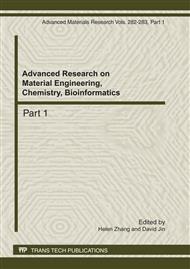[1]
V. Vapnik, and A. Lerner, Pattern Recognition Using Generalized Portrait Method. Automation and Remote Control 24 (1963), pp.774-780.
Google Scholar
[2]
J. Platt, Sequential minimal optimization: A fast algorithm for training support vector machines. Advances in Kernel MethodsSupport Vector Learning 208 (1998), pp.1-21.
DOI: 10.7551/mitpress/1130.003.0016
Google Scholar
[3]
X. Liu, and Z. Chen, A Fast Classification Algorithm of Support Vector Machines. Journal Of Computer Research And Development 41 (2004).
Google Scholar
[4]
B. Schölkopf, Chris Burges, and V. Vapnik, Extracting support data for a given task. in: U.M. Fayyad, and R. Uthurusamy, (Eds. ), First International Conference on Knowledge Discovery and Data Mining, AAAI Press, Menlo Park, Canada, (1995).
Google Scholar
[5]
E. Osuna, R. Freund, and F. Girosi, Improved Training Algorithm for Support Vector Machines, Procedings of the IEEE NNSP, Amelia Island, 1997, pp.276-285.
DOI: 10.1109/nnsp.1997.622408
Google Scholar
[6]
R. Collobert, S. Bengio, and Y. Bengio, A parallel mixture of SVMs for very large scale problems. Neural Computation 14 (2002), pp.1105-1114.
DOI: 10.1162/089976602753633402
Google Scholar
[7]
A.G. Ivakhnenko, Heuristic self-organization in problems of engineering cybernetics. Automatica 6 (1970), pp.207-219.
DOI: 10.1016/0005-1098(70)90092-0
Google Scholar
[8]
A.G. Ivakhnenko, The group method of data handling-a rival of the method of stochastic approximation. Soviet Automatic Control 13 (1968), pp.43-55.
Google Scholar
[9]
J.A. Mueller, and F. Lemke, Self-organising data mining: An Intelligent Approach To Extract Knowledge From Data, Libri, Hamburg, (1999).
Google Scholar
[10]
C. He, and J. Liu, Study of Self-organizing Data Mining Theory and the Complexity of Economic Systems. Systems Engineering - Theory & Practice 21 (2001), pp.1-5.
Google Scholar
[11]
H. Tamura, and T. Kondo, Revised GMDH algorithm using prediction sum of squared (PSS) as a criterion for models selection. Trans. Instrument and Control Engineering 14 (1978), pp.519-524.
DOI: 10.9746/sicetr1965.14.519
Google Scholar


